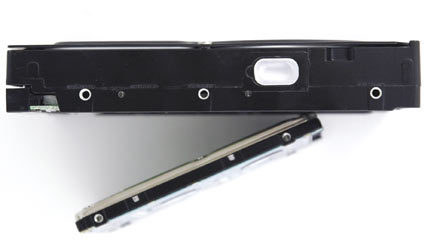The 2.5" vs. 3.5" RAID Challenge
2.5" Vs. 3.5" - Storage Density Allows For High I/O Performance
The images show pretty clearly the differences between 3.5" and 2.5" hard drives. One of the most important things to know is the fact that a 3.5" hard drive will always outperform a comparable 2.5" model using the same data density and spindle speed.
The large platter diameter of 3.5" drives results in a higher absolute velocity of the outer sectors. As they pass the read/write heads, this can be converted into higher data transfer performance: the fastest 3.5" SATA drives reach 69 MB/s while 2.5" drives remain at 40 MB/s maximum. Also, desktop drives usually spin at 7,200 RPM, while most notebook 2.5" models rotate at just 4,200 RPM, which makes a big difference. It's true though that more manufacturers are switching to 5,400 RPM, but only one 2.5" drive, Hitachi's TravelStar 7K60, runs at 7,200 RPM. Along with the benefits in data transfer performance, a faster spindle speed results in decreasing rotational latency, the time that the heads have to wait until the requested sector passes by.
More and more 2.5" notebook hard drives using the SATA interface will be released soon, but we also expect several models to be validated for server applications. Thanks to SATA and SAS, decent infrastructures are either already there or will be built up this year. Let us take a look at one example.
A 19" 1U rackmount device usually hosts up to four 3.5" hard drives in removable frames. However, equipping such a device with smaller 2.5" drives allows the deployment of ten drives in the same space. It is pretty obvious that so many drives should have an easier time with large numbers of random queries that would push a four-drive 3.5" array to its limits.
Get Tom's Hardware's best news and in-depth reviews, straight to your inbox.
Current page: 2.5" Vs. 3.5" - Storage Density Allows For High I/O Performance
Prev Page The 2.5" Vs. 3.5" RAID Challenge Next Page 2.5" Fujitsu MHT2060BS
Patrick Schmid was the editor-in-chief for Tom's Hardware from 2005 to 2006. He wrote numerous articles on a wide range of hardware topics, including storage, CPUs, and system builds.
-
If you look closely you will see that this review compared 5400rpm 2.5" drives with 7200rpm 3.5" drives.Reply
Which makes it completely useless and flawed. I seriously can't believe Tom's did that. Maybe if there had been 5400rpm 3.5" drives included, some useful information could be gleaned from the tests.
This entire article should be deleted just to save face, if not disk space. This article's very existence makes me embarrassed for Tom's Hardware. -
AgreeReply
This is ridiculous
the outside speed of the platter !!
I cannot believe it .. you wait one turn never mind where your data are located and at 7200rpm your platter may be 1 meter in diameter it is not going to change anything it will stl be one rouind trip
You will wait one turn ( 1/7200th of a second )
It ain't go faster nor slower mechanically
The heads are another story


